
The History of Cat Litter and Litter Boxes
The History of Cat Litter and Litter Boxes edited 2024 by Layla Morgan Wilde.
Let’s face it, cleaning a litter box is no one’s favorite chore but we’ve come a very long way.
We do it daily because we love our kitties and cleaning the litter box is a necessity just like changing a diaper or disinfecting our toilets. Americans are resourceful and not surprisingly early litter boxes were by-products impacting pet loving society. Without litter and litter boxes we’d probably own less cats.
Have you ever thought about the litter box maintenance? If you owned a cat in the past 20 years, odds are you’ve used clumping litter. We simply scoop and toss. But our ancestors had to put a great deal of effort into keeping an inside cat.
According to Katherine Grier, Ph.D., professor of history at University of Delaware, most cats lived outside until after WWII. They did their business in backyards and flower beds.
(They lived separated from the people who loved them because of the elimination issue and also because few people altered them, and intact kitties express themselves in ways not conducive with civilized indoor living. But increasingly, cat lovers wanted to keep their cats safely inside the home and be more a family member.
To this day indoor/outdoor cats prefer but a natural setting most cats and relieved themselves in loose ground, then covered their waste. Our Odin demonstrates.

This tidy nature hid their presence from predators and competitors, and protected them from disease and parasites. Unlike dogs, cats didn’t require housebreaking. They simply needed loose material. Some cats enjoy digging more and having room to stretch out like our indoor/outdoor boy Odin.
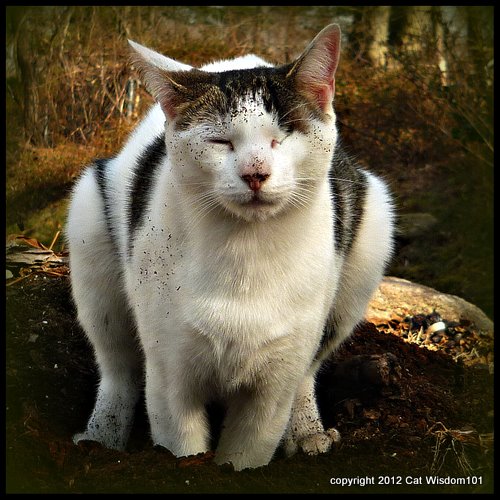
People began providing inside kitties with “sanitary pans,” usually 12” by 18” graniteware enamel baking pans or 22” by 4” deep galvanized iron roasting pans
To these dedicated ailurophiles, the sand man didn’t have anything to do with sweet dreams. He brought a welcome supply of cat box sand. According to cat care books published between 1885 and the mid-1950s, inside cats could expect to find dirt, absorbent newspaper cat pads, shredded or folded newspaper, sawdust, or fireplace ashes in their pans.
These books recommended changing the filler and washing the pan twice a day, or daily at the very least.As any cat exits his sanitary pan he leaves dark paw prints all over the bathroom floor. Daily mopping is just one more step in the process. Ash residue immigrates to the carpet and linens. Keeping an inside cat was truly a labor of love.
Another precursor to clay cat litter came from an innovator named “Poppy” George Plitt, who sold Kleen Kitty, a cat box filler made from wood ashes.# Cat owners removed the poop with a kitchen frying strainer.
Just as today we can tell cat lovers by the telltale cat hair on their clothes, in the 1940s you looked for soot. I imagine gray apparel was quite popular among cat fanatics.
In January, 1947 Kay Draper, a cat lover from Cassopolis, Michigan, couldn’t reach her cat sand pile because of a deep layer of snow, so her Angora cat was tracking sooty paw prints all over the house. She asked her neighbor, Ed Lowe (who sold clay granules and sand), if she could purchase some sand.
Fortunately, the snow also prevented him from accessing his sand reserves. He suggested she try Fuller’s Earth, kiln-dried clay granules he’d been attempting to sell to chicken farmers as nesting material.
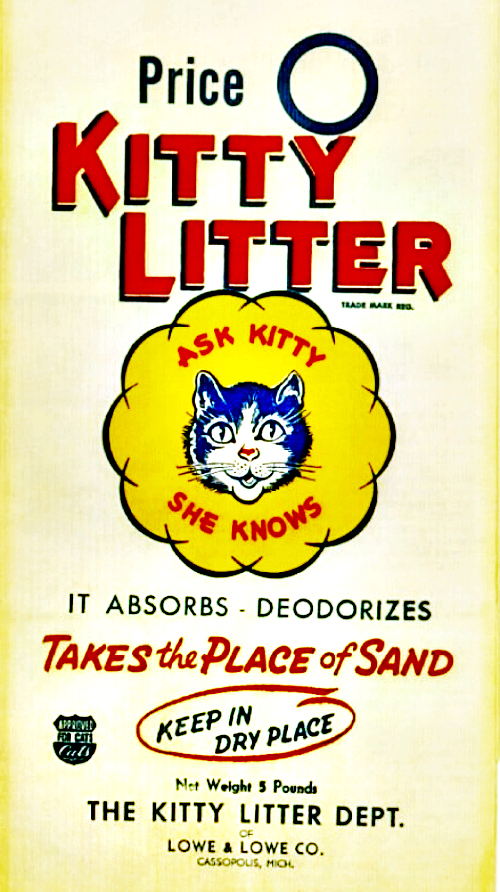
Like a stray who found a full food bowl, she came back for refills and brought her cat lady friends with her. Lowe wondered if other cat owners would be as enthusiastic.
To test the market, he filled ten 5-pound sacks with KITTY LITTER™ and asked a local pet store to sell it for 69 cents each. The shop owner doubted his customers would pay that, but within a few weeks he placed an order for more. By the early 1950s KITTY LITTER (later Tidy Cats™) became widely available in pet stores.
Around the same time, the Oil-Dri Corporation was selling an absorbent clay to mop up automotive and other slippery spills. In 1947, they sold the same product re-purposed for cat litter. In the 1950s, new kinds of clay were introduced and in 1961 the brand Cat’s Pride® Cat Litter was introduced to the pet care market.
While a few brands of canned cat food were available in until the ’60s, most people fed their cats table scraps and bread, and of course cream. (Imagine the smell of that litter box.) Despite the horrible diet provided by their people, I believe because cats stayed healthy because they were often working mousers.
Progress continued and in 1969, Oil-Dri expanded its cat litter and grease absorbent businesses to the European market. The Company made its first cat litter sale to Walmart in 1972. Oil-Dri established a strategic alliance with The Clorox Company and jointly developed Fresh Step® coarse cat litter.
Finally, in the mid-80s a Cat’s Pride Scented cat litter was introduced to the market. Many other brands followed included naturally scented ones with in the past ten years.
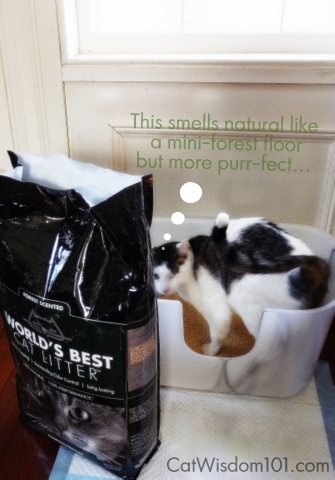
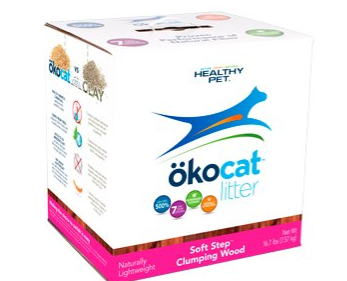
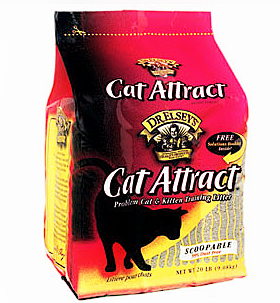
Since then dozens of brands of every texture and material including corn, wheat, pine, wood, walnut shells and silicone granules. Consumer preference remains fickle with some cats preferring unscented litter and every cat owner prefers low-tracking dust-free.
1996 was the watershed year for easier litter scooping with clumping litter and portable, disposable litter boxes.
We’ve come a long and I’m grateful for the large high-sided boxes invented a few years ago. Our choices have flip-flopped over the years and currently have two or three favorites.
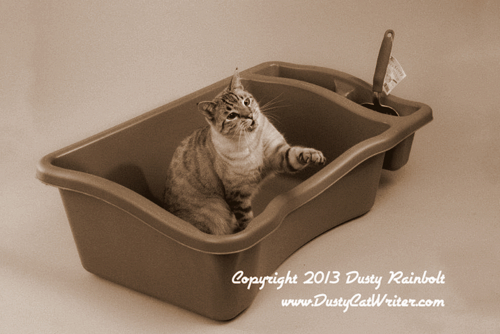
So next time you feel tempted to complain about litter box duty, think about those cat-loving pioneers who made your life more convenient and your air more pleasant. I doubt that the task at hand will seem quite as bad and you’re cat will love you more if you keep it cleaned once or twice a day.
Images of litter pans courtesy of Dusty Rainbolt, author and cat behavior consultant is editor-in-chief at AdoptAShelter.com


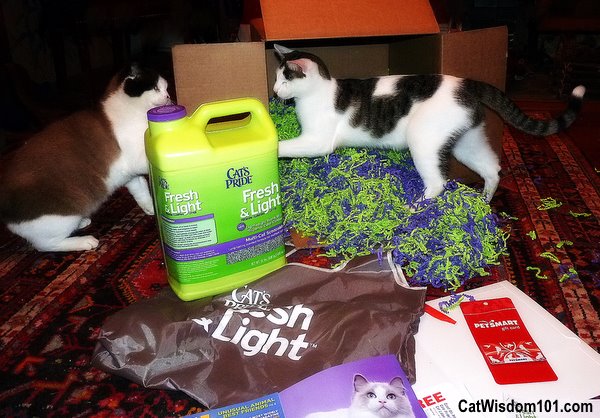
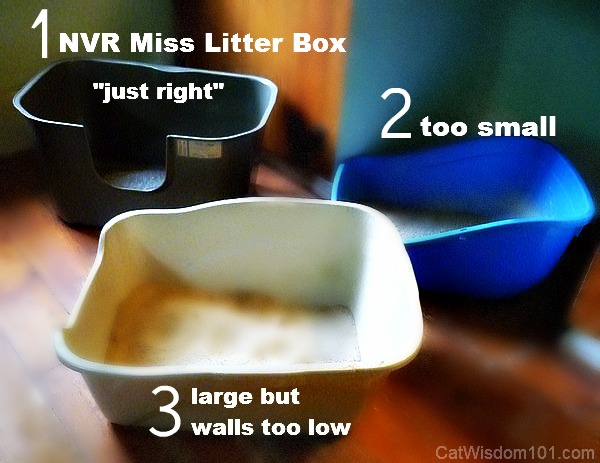
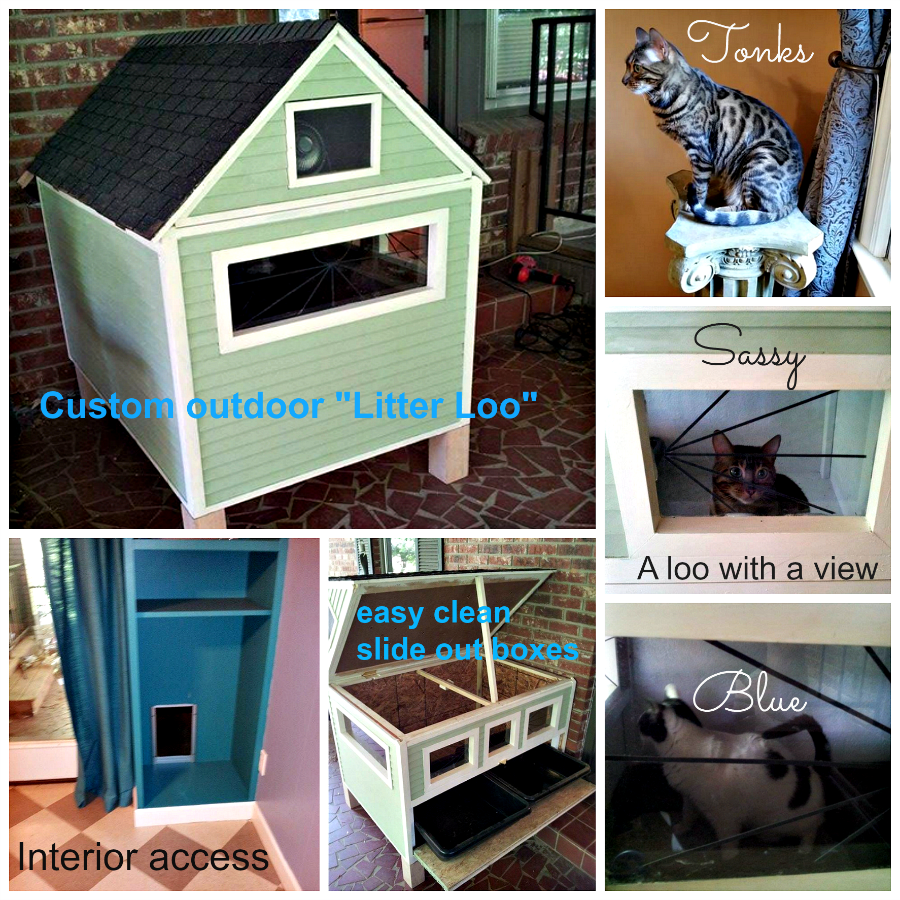
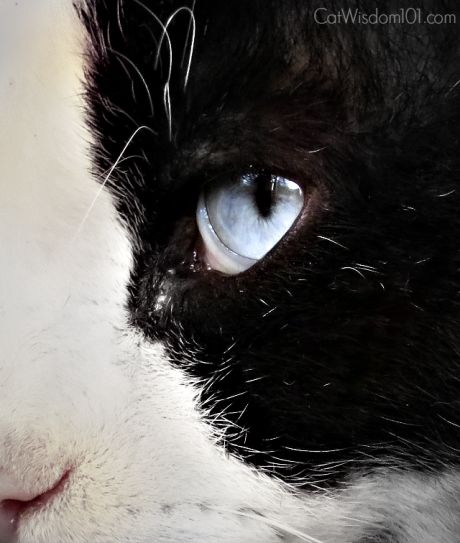
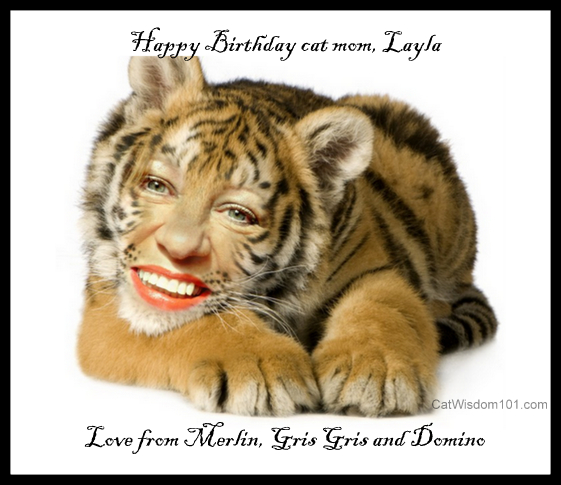
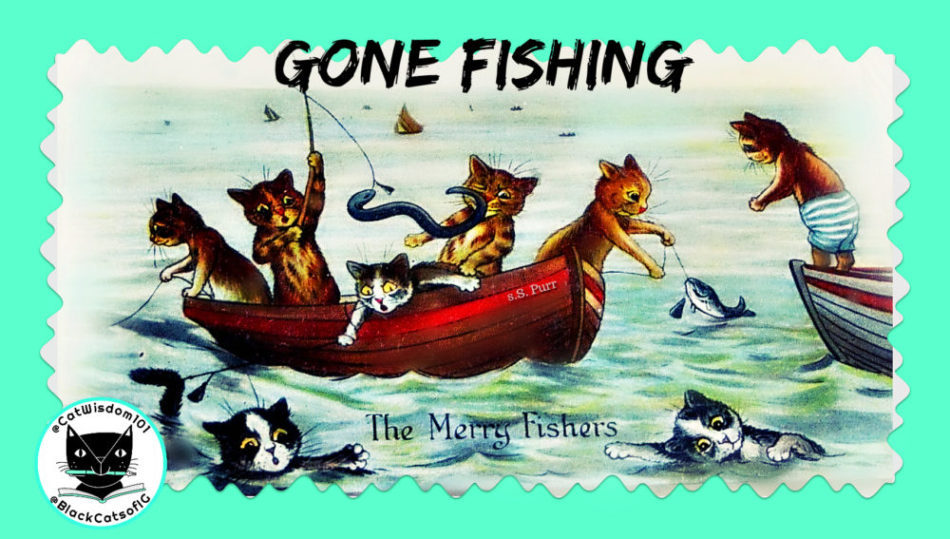
19 Comments
Alison
Thanks for this great info. A reminder that the kitty dark ages were not so long ago. Thank goodness for progress, at least on the cat-litter front.
Heather
I never thought about the history of litter before. This was very interesting. My too loves are history/genealogy and cats oh and manatees. 🙂
Kathryn
Oh my, this is so fascinating. My father grew up on a farm/ranch, and they had cats as outdoor cats to catch the mice and fed them table scraps. When I was a child, our cats were outdoors during part of the day and home at night with us, fed on disgusting canned tuna-cat food and milk and water. We brought in a stud every so often to breed with the Siamese, and then gave the kittens away, and kept a few. Later, we fed our cats Purina dry food. We had a liter box in the house, I think, but do not actually remember it. Maybe they were outdoors most of the time.
Yes, the box is a major issue. Our two wonderful boys are big.
Anonymous
I remember that we did not have a litter box in the house. They did their dooty outside. Two got ringworm, which I then got, so Tawny and Ginger (Siamese) ‘went to the nuns.’ This is what I was told. Siami,. the grandson, ran away when I took in a stray. Kitty I and Kitty II were indoor/ outdoor cats. Kitty I climbed trees, then howled until the fire department got her down. Kitty II lived until 15. She hated our Lakeland Terrier puppy, Rochelle, and swatted at Rochelle to keep her away. She got kidney disease at 15. Emma Peel, 1972-1992 was an indoor only cat, and had a delicate stomach, so wet food only. I give Cheddar Oleski wet only, Fancy Feast, Sheba, Friskies, no fish. Huggy and Calico met their end on a busy street. Calico ate everything from our plate. We had to keep her in the bathroom, with a plate of her own food, so she wouldn’t eat our cheese, meat, macaroni, anything. Mao retired last week to his reward in heaven; he had chronic kidney disease. 16 years.
Feather
Just discovered your blog and LUV it! Wish i wasn’t at work so I could go on reading! 🙂 I could really use this wonderful gadget as I just moved into a new smaller apartment and seem to be having more probs with the litterbox and garbage smells as well as too much dust! I’m already planning on plugging in my regular purifier in the bedroom for my asthma and allergies but something that kills nasty odours as well would be FAB! And it’s so teeny! Purrfect! Thanks for the opportunity.
kb
Hi, there are a couple of litters that can be flushed and they keep the home much cleaner and odor-free. The one i like best is Garfield Tiny Grains Flushable (can be ordered from Amazon or Chewy). The other one is World’s Best Cat Litter. I actually mix the 2 together to get the right consistency for our 3 cats. Good luck and purrs to all!
Skeeter and Izzy
Such a cool post! We learn something every time we come here!
Luvs Skeeter and Izzy and the Feral Gang >^..^<
Sue Brandes
Great post. I am so happy to have clumping litter. I remember having to use clay litter. And I love the bigger cat boxes they have now.
Angel Abby
Well that is something we had never thought of. How interesting. Thank you for such an informative article.
Tamago
How interesting! I never imagined how kitty litter and litter boxes developed.
I’m glad we have nice clumping litter 🙂
da tabbies o trout towne
doodz…we loved thiz post tho we gotta add mitt we wuz yellin at de top oh R lungs ta tell de kitteh KNOT ta use de stoooooooooopid “burd baster” aza box 🙂 !!~~~~~
Brian
That was quite interesting and I had no idea! Oh yea, you covered in nicely MOL!
Betty Smith
Great article! I still scoop more than once a day but am glad I don’t have to do a complete break down and wash. Interesting that companies are still trying out “new” fillers…shredded newspaper, wheat, pine pellets and, my current favorite, walnut shell pellets. I wonder what they will come up with next?
easy rider
mom’s granny had exactly such a pan, but she never had a kitty. I’m not sure if she made the sunday roast in a cat litter box …
Nerissa's Life
I shall remind my peeps of this… DAILY!
Purrs,
Nissy
Sometimes, Cats Herd You
Wow, we’re glad that cat litter has come a long way since peeps first got the idea to let cats do their business inside. We like our current arrangement much better than the sooty-paws ones.
Tillie and Georgia
We like the litter boxes of today too 🙂
Purrs Tillie and Georgia,
Treasure,Tiger, JJ and Julie
Sparkle
I am SO glad to be a kitty of the 21st century!
Janet Valentine
This was fascinating! Now I just have to locate Dr. Elsey’s Cat Attract Litter. But first I have to persuade my husband to let me have a cat. My sweet tamed feral died last year and I’m having trouble being catless. So thank goodness for your site, I love following your kitties’ adventures!
Hmm, comment below about unable to access my website. I have no trouble getting to it, though I did have to renew my lease on the domain name recently, so I recommend trying again: http://www.valentineland.net
It works!
Cheers,
Janet
Thanks,
Janet Valentine